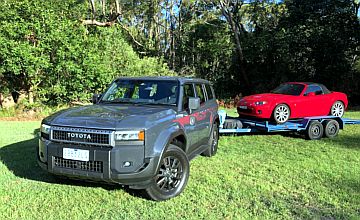Make / Model Search
OptionsCar reviews - Toyota - LandCruiser Prado - GXToyota modelsOverviewWe like Appealing style, roomy interior, well-featured, strong engine, good fuel economy while towing, comfortable on long drives Room for improvement Pesky ADAS, Tow/Haul function not fully resolved, rattly tow hitch, average high beam How does towing with the new Toyota LandCruiser Prado compare to our own Fortuner?17 Feb 2025 OverviewPlenty has been written about the new fifth-generation Toyota Prado 250 Series, much of it praiseworthy, though some criticisms have stemmed from operator error. As many Prados are used for towing duties, pulling caravans, boats, cars, and box trailers, we wanted to find out firsthand how it performs. We took the base model GX ($72,500 before on-road costs) on a long 800km trip with a 2.0-tonne rig in tow to see what it was like.
The new Prado has several direct four-wheel drive, diesel, ladder-chassis competitors, including the Isuzu MU-X 3.0 (from $55,400), Mitsubishi Pajero Sport (from $51,540), Ford Everest (from $59,240), and Toyota’s own Fortuner (from $53,775), all excluding on-road costs.
So the Prado comes at a considerable premium over the others, albeit with the benefit of being the newest model and that desirable LandCruiser badge.
The five-seat GX base model is well equipped but includes some annoying "driver assist" features that Prado owners will likely dislike.
For the price, the Prado gets a new TNGA-F chassis, boxy new styling reminiscent of the Land Rover Defender, a lift-up tailgate, and a full-size spare beneath the chassis rails.
The vehicle has a longer wheelbase at 2850mm (up 60mm), broader front and rear tracks at 1664mm and 1668mm (up 79mm and 83mm, respectively), and a length of 4990mm and width of 1980mm (up 95mm).
The body length is 165mm longer than its predecessor, but the overall length is only 5mm more, thanks to the removal of the boot-mounted spare tyre.
GX ground clearance is now 210mm, the turning circle increases to 12.0m, and the cabin offers more room while luggage space also increases.
Braked towing capacity is now 3500kg, an increase of 500kg from the previous model.
Power comes from a carryover 2.8-litre four-cylinder turbo-diesel rated at 150kW/500Nm, equipped with a 48-volt electric motor assist for NVES purposes. Full-time 4WD is via an eight-speed automatic transmission.
The steering is electric-assisted, as is the parking brake, which may be problematic for off-road driving.
Standard equipment includes a 12.3-inch touchscreen infotainment array paired with a 7.0-inch colour multi-information display, a panoramic view monitor, a 10-speaker audio system with DAB+ digital radio, and four USB-C charging ports.
Every trim level is equipped with cloud-based navigation, wireless Apple CarPlay, wireless Android Auto, plus compatibility with Toyota Connected Services through the myToyota Connect smartphone app.
All new Prados are fitted with Toyota’s latest active safety technologies, including a pre-collision system, all-speed adaptive cruise control, and lane trace assist.
Towing ImpressionsThere’s a new Toyota Fortuner GXL in our garage, which we love, and it served as a good benchmark against which to compare the new Prado.
Straight up, we like the new Prado, particularly its styling, which is more macho than the model it replaces, and the interior is just as appealing, even with fabric seats and rubber floor mats (preferable in many cases).
The GX specification presents a tough and well-equipped vehicle. The mica grey test vehicle was equipped with an all-important tow hitch complete with dual safety chain lugs and a double redundant gooseneck pin with a large nut and an R clip on one side.
The tailgate can be opened without hitting the top of the tow hitch, and the tow ball is far enough away from the bumper to make trailer hitching worry-free.
Our trailer doesn’t have electric brakes but is equipped with override discs that work fine (when adjusted correctly).
The combined mass of the trailer and a car onboard was 2.0 tonnes – well within the 3500kg limit of the new Prado.
Unlike our Fortuner, which squatted in the rear when towing until we fitted air-assist rear suspension bags, the Prado remains flat with a loaded trailer on the back, meaning the headlights stay focused, the steering retains standard feel, and other dynamics are pretty much textbook.
The standard 18-inch tyres on smart black-painted alloys were inflated to 37psi and delivered stable, predictable tracking throughout the drive, even at high speeds on the freeway and with strong crosswinds at times.
The all-important engine performance couldn’t be faulted, as the new Prado hardly noticed the extra weight behind. Fuel consumption jumped, as expected, to a reasonable 11.1 litres/100km from 8.2 without a trailer.
The test vehicle exhibited good acceleration off the mark, strong response on the move, certainly enough to overtake with confidence, and never felt to be working hard.
We activated the Tow/Haul mode but didn’t like the way it made the Prado drive in too low a gear (unnecessarily, in our opinion) and kick down for engine braking too soon, again unnecessarily, in our opinion.
The system is said to provide a strong engine response, but we couldn’t tell the difference between it and the Normal drive mode. Sport and Eco modes are also available, neither of which we thought were necessary, so it was in Normal all the time.
No paddle shifters are fitted, but "manual" changes can be made using a parallel gate on the gear selector, mounted in the right place in front of the centre stack. We didn’t bother, preferring the slick eight-speed transmission to handle gear selection duties, which it did perfectly.
Over sometimes undulating roads, the Prado’s suspension soaked up irregularities as if they weren’t there, with no porpoising noted from the trailer.
Once cruise speed was attained, minimal noise penetrated the cabin, save for minor wind rustle from the A-pillar/exterior mirror area.
We used the radar cruise control frequently and found it useful, particularly as it maintained the set speed uphill and down dale, thanks in part to the eight-speed automatic flicking up and down the range imperceptibly.
We drove part of the trip in the dark and found the low beam OK but the high beam was a tad dull.
The camera systems on the vehicle are handy accompaniments when towing and parking, but the park assist is downright dangerous, panic stopping in reverse due to the trailer’s presence unless Tow/Haul mode is selected.
The same goes for the autonomous emergency braking (AEB) at the front, which is too easily spooked, jumping on the stoppers alarmingly at times. To say nothing of the adaptive lane trace, which should, in our opinion, automatically turn off when towing.
The Prado’s 110-litre fuel tank is a boon for long-distance driving, giving close to 800km of towing range without needing to refuel.
It’s comfortable inside, even in base model specification, and there’s even a premium 10-speaker audio system to enjoy on those long trips. Plenty of luggage space, too, in the roomy cabin.
So how does it compare against our own towing mule, the 2023 Fortuner GXL?
Well, it's pretty good, but not so good that we would trade the ’Tuner in because it performs about the same, uses less fuel, rides better with the $400 air-assisted rear suspension, and costs considerably less. And you can turn off the lane-keeping assist, which stays off.  Read more29th of November 2024  2025 Toyota LandCruiser Prado Altitude ReviewToyota broadens Prado range with new dirt-ready Altitude five-seat variant25th of November 2024  Market Insight: New Prado to lead the packToyota predicts record-setting sales for new Prado, return to pole position in 202525th of November 2024  LandCruiser Prado chassis secrets revealedTNGA-F chassis a solid foundation for new Prado, likely to underpin next-gen HiLuxAll car reviews Alfa Romeo Alfa Romeo Abarth Abarth Audi Audi Aston Martin Aston Martin BMW BMW Bentley Bentley Chrysler Chrysler Chevrolet Chevrolet Dodge Dodge Citroen Citroen Ferrari Ferrari DS DS Ford Ford Fiat Fiat FPV FPV Foton Foton Haval Haval Great Wall Great Wall Honda Honda Holden Holden Hyundai Hyundai HSV HSV Isuzu Isuzu Infiniti Infiniti Jaguar Jaguar Iveco Iveco Kia Kia Jeep Jeep Land Rover Land Rover Lamborghini Lamborghini Maserati Maserati Lexus Lexus McLaren McLaren Mazda Mazda Mercedes-Benz Mercedes-Benz Mitsubishi Mitsubishi Mini Mini Opel Opel Nissan Nissan Porsche Porsche Peugeot Peugeot Ram Ram Proton Proton Rolls-Royce Rolls-Royce Renault Renault Skoda Skoda Saab Saab SsangYong SsangYong Smart Smart Suzuki Suzuki Subaru Subaru Toyota Toyota Tesla Tesla Volvo Volvo |
OptionsClick to share
|











Facebook Twitter Instagram